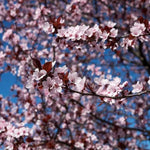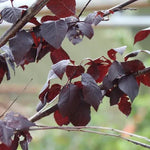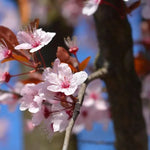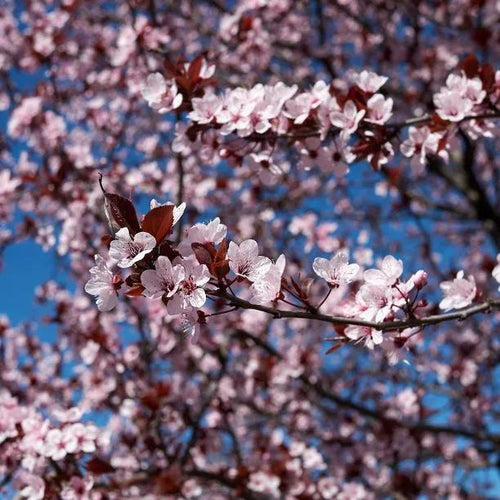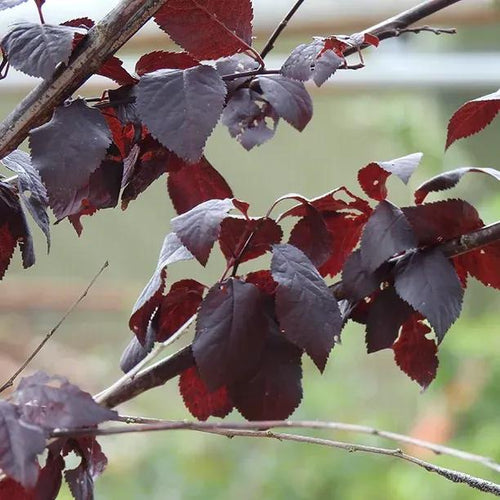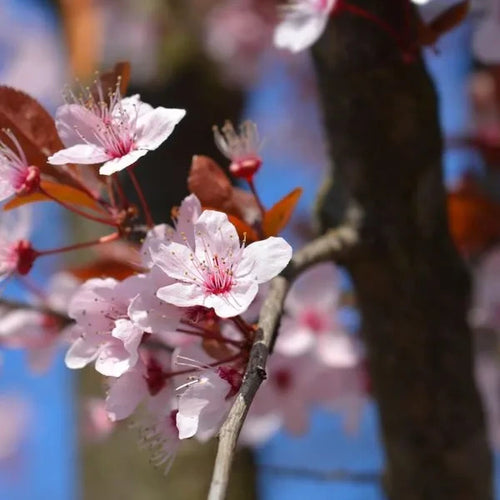Purple-Leaved Cherry Trees, Large Standards
Purple-Leaf Cherry, the tough and beautiful Prunus cerasifera Nigra, AKA black cherry plum, is a firm urban favourite, with its top tier reliability in poor soils, spectacular spring blossom and great foliage colour. It's one of the first cherries to flower, coming into bud in late February in warm areas. The buds open into blush-pink, single flowers, contrasted against rich burgundy-black-purple stems. Soon, glossy, pale copper new leaves emerge, which mature to deep purple, then fire up to rich reds and orange in autumn, providing interest throughout most of the year. In the winter months its dense mushroom-shaped crown brings pleasing structure.
Browse our other ornamental cherry trees, or buy the slightly less ornamental wild Prunus cerasifera, which is great for hedges.
It does bear fruit, although not regularly. The juicy red plums are sweet, and are better for making jam than eating fresh.
Delivery season: Cherry plums are delivered bareroot during late autumn and winter, approximately November-March inclusive.
Choosing a size: Small trees are cheaper, easier to handle and more forgiving of less than ideal aftercare, so they're best for a big planting project. If instant impact is your priority, or if you are only buying a few plants for use in a place where it's convenient to water them well in their first year, then you may as well use bigger ones. All our bareroot trees are measured by their height in centimetres above the ground (the roots aren't measured).
Features
- Final height/spread: 8m x 6m
- Foliage: deciduous, deep purple
- Use: specimen, street tree
- Pink spring blossom can start in Feb. March-April is normal.
- Richly coloured foliage in spring, summer and autumn
- Soil: well drained
- Native: no
- RHS Award of Garden Merit
Growing Purple Leaf Cherry Plum Trees
Give it a bit of sun, plant on soil that's not waterlogged, and it'll grow. It'll tolerate all but the toughest of conditions. It's shallow rooted, so it's ideal on streets and next to structures: town planners love it.
It's a gorgeous small tree, perfect for small and medium gardens, where it'll give you good screening planted in front of a shed or outbuildings. It makes a brilliant specimen, or a subject for an avenue of trees: imagine tree after tree covered in blossom in early spring. Underplant your tree with plenty of early spring bulbs for a fabulous show in March. Choose crocus bulbs in pale and interesting shades to complement the tree's soft-pink blossom, dark bark, and mature leaves.
History & Trivia
Cerasi- means cherry, and the ending -fera means to carry or bear something, like an aqui-fer bears water (see also Christopher), and Nigra is black.
Bred in the USA in 1916, it is also sold as Prunus Blaze or Pissardii Nigra.
Standard trees are measured by their girth in centimetres 1 metre above ground level: their trunk's waist measurement. Unlike sapling trees and hedge plants, standards aren't measured by their height, which will vary quite a bit both between and within species.
So, a 6/8cm standard tree has a trunk with a circumference of 6-8cm and an 8/10 standard has a trunk 8-10cm around. This measurement makes no difference to the tree's final height.
On average, standard trees are 2-3.5 metres tall when they arrive, but we cannot tell you precisely how tall your trees will be before we deliver them.








 Secure, One-Tap Checkout
Secure, One-Tap Checkout
 Hand Picked, Delivered to Your Door!
Hand Picked, Delivered to Your Door! 1 Year Bareroot Guarantee
1 Year Bareroot Guarantee